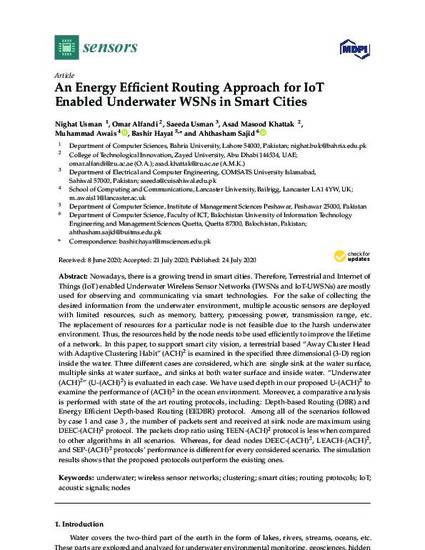
© 2020 by the authors. Licensee MDPI, Basel, Switzerland. Nowadays, there is a growing trend in smart cities. Therefore, Terrestrial and Internet of Things (IoT) enabled Underwater Wireless Sensor Networks (TWSNs and IoT-UWSNs) are mostly used for observing and communicating via smart technologies. For the sake of collecting the desired information from the underwater environment, multiple acoustic sensors are deployed with limited resources, such as memory, battery, processing power, transmission range, etc. The replacement of resources for a particular node is not feasible due to the harsh underwater environment. Thus, the resources held by the node needs to be used efficiently to improve the lifetime of a network. In this paper, to support smart city vision, a terrestrial based “Away Cluster Head with Adaptive Clustering Habit” (ACH)2 is examined in the specified three dimensional (3-D) region inside the water. Three different cases are considered, which are: single sink at the water surface, multiple sinks at water surface„ and sinks at both water surface and inside water. “Underwater (ACH)2 ” (U-(ACH)2) is evaluated in each case. We have used depth in our proposed U-(ACH)2 to examine the performance of (ACH)2 in the ocean environment. Moreover, a comparative analysis is performed with state of the art routing protocols, including: Depth-based Routing (DBR) and Energy Efficient Depth-based Routing (EEDBR) protocol. Among all of the scenarios followed by case 1 and case 3, the number of packets sent and received at sink node are maximum using DEEC-(ACH)2 protocol. The packets drop ratio using TEEN-(ACH)2 protocol is less when compared to other algorithms in all scenarios. Whereas, for dead nodes DEEC-(ACH)2, LEACH-(ACH)2, and SEP-(ACH)2 protocols’ performance is different for every considered scenario. The simulation results shows that the proposed protocols outperform the existing ones.
- Acoustic signals,
- Clustering,
- IoT,
- Nodes,
- Routing protocols,
- Smart cities,
- Underwater,
- Wireless sensor networks
Available at: http://works.bepress.com/omar-alfandi/46/